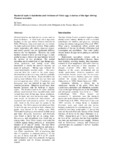Whole-genome sequencing for identification of bacterial isolates affecting local penaeid shrimp farms: A national survey for the Philippines
| dc.contributor.author | Saloma, Cynthia | |
| dc.contributor.author | Penir, Sarah Mae | |
| dc.contributor.author | de la Peña, Leobert D. | |
| dc.contributor.author | Amar, Edgar | |
| dc.contributor.editor | Alday-Sanz, Victoria | |
| dc.date.accessioned | 2022-04-11T03:51:04Z | |
| dc.date.available | 2022-04-11T03:51:04Z | |
| dc.date.issued | 2022 | |
| dc.identifier.citation | Saloma, C. P., Penir, S. M. U., de la Peña, L. D., & Amar, E. C. (2022). Whole-genome sequencing for identification of bacterial isolates affecting local penaeid shrimp farms: A national survey for the Philippines. In V. Alday-Sanz (Ed.), The Shrimp Book II (pp. 485–497). 5M Books Ltd. | en |
| dc.identifier.isbn | 9781789181043 | |
| dc.identifier.uri | http://hdl.handle.net/10862/6319 | |
| dc.description.abstract | The shrimp aquaculture industry is a major economic player in the food and livelihood sectors, both globally and in the Philippines. The development of industrialized shrimp farming methods has led to a rapid increase in cultured shrimp production since the 1980s, but the industry has also faced challenges from the introduction of opportunistic pathogens. These pose severe limitations in the success of shrimp culture in both hatcheries and grow-out ponds. We extracted genomic DNA from 423 bacterial isolates from shrimp disease outbreaks in local aquaculture farms throughout the Philippines and subjected them to Illumina paired-end whole-genome sequencing at 50–100-fold coverage. Reads were assembled using a de novo approach, and average nucleotide identity measurements were used to establish the identity of the isolates. Outbreak types encountered during the time of sampling include acute hepatopancreatic necrosis disease (AHPND), luminescent vibriosis, white spot disease, and outbreaks of unknown etiology. In both outbreak and non-outbreak sites, members of the genus Vibrio, particularly Vibrio parahaemolyticus, were observed to be the most abundant. The whole-genome sequence data obtained will aid in the design and implementation of novel shrimp bacterial disease outbreak management and control programs. | en |
| dc.description.sponsorship | The authors acknowledge the Aquaculture Department of the Southeast Asian Fisheries Development Center (SEAFDEC), the Negros Prawn Growers’ Cooperative, the Bureau of Fisheries and Aquatic Resources, and the many fish pond operators throughout the country and various research assistants employed by the program for help in the collection of bacterial isolates used in this study; and the UP Philippine Genome Center – DNA Sequencing Core Facility (PGC-DSCF) and Core Facility for Bioinformatics (PGC-CFB) for providing sequencing and bioinformatics analysis services, and Ms Krizelle Alcantara for her assistance in the preparation of this manuscript. This work was made possible through the funding support of the Philippine Council for Agriculture, Aquatic and Natural Resources Research and Development of the Department of Science and Technology (PCAARRD-DOST) for the project “Shrimp Pathogenomics Towards a Competitive and Sustainable Shrimp Industry” under the program “Development of Diagnostic Tools Through Genomics and Establishment of the Philippine Aquatic Pathogen Database Resource for the Philippine Aquaculture Industry”. The authors are grateful for the help provided by Drs Adelle Calpe and Dalisay Fernandez of PCAARRD-DOST in the implementation of the program. | en |
| dc.language.iso | en | en |
| dc.publisher | 5M Books Ltd | en |
| dc.subject | Vibrio | en |
| dc.subject | Vibrio parahaemolyticus | en |
| dc.subject | isolation | en |
| dc.subject | prawns and shrimps | en |
| dc.subject | Philippines | en |
| dc.title | Whole-genome sequencing for identification of bacterial isolates affecting local penaeid shrimp farms: A national survey for the Philippines | en |
| dc.type | Book chapter | en |
| dc.citation.spage | 485 | |
| dc.citation.epage | 497 | |
| dc.citation.bookTitle | The Shrimp Book II | en |
| dc.subject.asfa | shrimp culture | en |
| dc.subject.asfa | genomes | en |
| dc.subject.asfa | sequencing | en |
| dc.subject.asfa | Bacteria | en |
| dc.subject.asfa | DNA | en |
| dc.subject.asfa | diseases | en |
| dc.subject.scientificName | Vibrio | en |
| dc.subject.scientificName | Vibrio parahaemolyticus | en |
| dc.subject.scientificName | Penaeidae | en |
このアイテムのファイル
| ファイル | サイズ | フォーマット | 閲覧 |
|---|---|---|---|
|
このアイテムに関連するファイルは存在しません。 |
|||
このアイテムは次のコレクションに所属しています
-
Books and Book Chapters [123]




